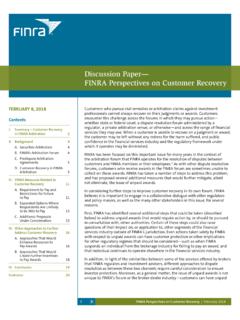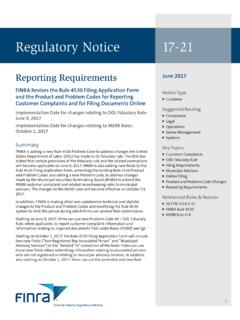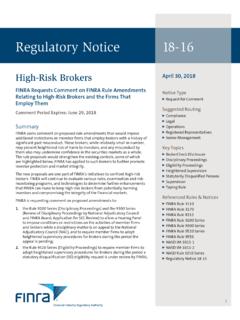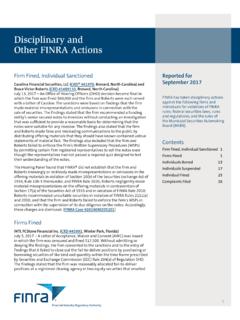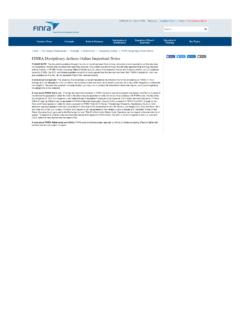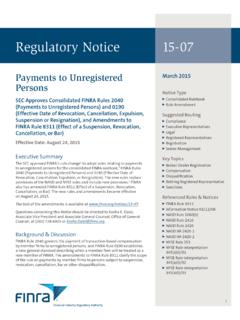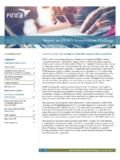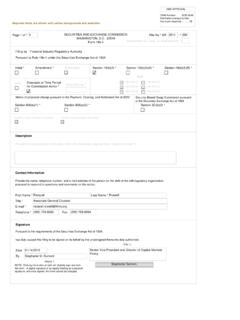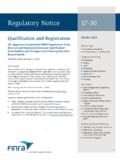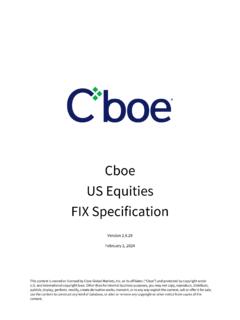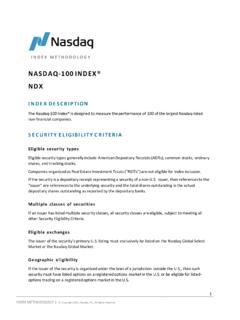Transcription of Securities Industry Essentials (SIE) Examination
1 Securities Industry Essentials (SIE). Examination CONTENT OUTLINE. 2021 FINRA. PURPOSE OF THE EXAM. The Securities Industry Essentials (SIE) exam assesses a candidate's basic knowledge of the Securities Industry . The exam focuses on Industry terminology, Securities products, the structure and function of the markets, regulatory agencies and their functions, and regulated and prohibited practices. For more information about the SIE, see FINRA Rule STRUCTURE OF THE EXAM. The exam consists of 75 multiple-choice items, and each item consists of four answer choices. The allocation of test items is as follows: Percentage of Section Description Number of Items Exam Items 1 Knowledge of Capital Markets 16% 12. 2 Understanding Products and Their Risks 44% 33. Understanding Trading, Customer Accounts and 3 31% 23.
2 Prohibited Activities 4 Overview of the Regulatory Framework 9% 7. TOTAL 100% 75. Much of the content on the SIE outline is based on common Securities Industry knowledge and general concepts. This knowledge is often not based on any one rule or regulation. Examples include basic characteristics of investment products such as the relationship between the price and yield of a bond and the rights of a common stockholder. Alternately, some knowledge is based on specific rules and regulations. Examples include the reporting requirements for a Suspicious Activity Report (SAR) and the Uniform Application for Securities Industry Registration or Transfer (Form U4) filing requirements. The exam will assess candidates on both rule- and non-rule-based Industry knowledge. Several federal laws and regulations serve as the foundation for some of the knowledge contained in this outline.
3 The content upon which the outline is based includes but is not limited to rules and regulations under the following Acts: The Securities Act of 1933. The Securities Exchange Act of 1934. The Investment Company Act of 1940. The Investment Adviser Act of 1940. ADMINISTRATION OF THE EXAM. The exam is administered via computer. A tutorial on how to take the exam is provided prior to taking the exam. Each candidate's exam includes 10 additional, unidentified pretest items that do not contribute toward the candidate's score. The pretest items are randomly distributed throughout the exam. Therefore, each candidate's exam consists of a total of 85 items (75 scored and 10 unscored). There is no penalty for guessing. Therefore, candidates should attempt to answer all items. Candidates will be allowed 1 hour and 45 minutes to complete the SIE exam.
4 All candidate test scores are placed on a common scale using a statistical adjustment process known as equating. Equating scores to a common scale accounts for the slight variations in difficulty that may exist among the different sets of exam items that candidates receive. This allows for a fair comparison of scores and ensures that every candidate is held to the same passing standard regardless of which set of exam items they received. Candidates are not permitted to bring reference materials to their testing session. Severe penalties are imposed on candidates who cheat or attempt to cheat on FINRA-administered exams. Please visit for additional details. 2. Section 1: Knowledge of Capital Markets Regulatory Entities, Agencies and Market Participants The Securities and Exchange Commission (SEC).
5 The high-level purpose and mission of Securities regulation Definition, jurisdiction and authority of the SEC. Self-regulatory Organizations (SROs). Purpose and mission of an SRO. Jurisdiction and authority of SROs ( , cboe , FINRA, MSRB). Other Regulators and Agencies Department of the Treasury/IRS. State regulators ( , NASAA). The Federal Reserve Securities Investor Protection Corporation (SIPC). Federal Deposit Insurance Corporation (FDIC). Market Participants and their Roles Investors ( , accredited, institutional, retail). Broker-Dealers ( , introducing, clearing, prime brokers). Investment advisers Municipal advisors Issuers and underwriters Traders and market makers Custodians and trustees Transfer agents Depositories and clearing corporations ( , Depository Trust & Clearing Corporation (DTCC), options Clearing Corporation (OCC)).
6 Market Structure Types of Markets The primary market The secondary market ( , electronic, over-the-counter (OTC), physical). The third market The fourth market Economic Factors The Federal Reserve Board's Impact on Business Activity and Market Stability Monetary vs. fiscal policy Open market activities and impact on economy Different rates ( , interest rate, discount rate, federal funds rate). Business Economic Factors Purpose of financial statements ( , balance sheet, income statement). Business cycle ( , contraction, trough, expansion, peak). Indicators ( , leading, lagging, coincident, inflation). Basic effects on bond and equity markets ( , cyclical, defensive, growth). 3. Principal economic theories ( , Keynesian, Monetarist). International Economic Factors balance of payments Gross domestic product (GDP), gross national product (GNP).
7 Exchange rates Offerings Roles of participants ( , investment bankers, underwriting syndicate, municipal advisors). Types of offerings Public vs. private Securities offering Initial public offering (IPO), secondary offering and follow-on offering Methods of distribution ( , best efforts, firm commitment). Shelf registrations and distributions ( , definition, purpose). Types and purpose of offering documents and delivery requirements ( , official statement, program disclosure document, prospectus). Regulatory filing requirements and exemptions ( , SEC, blue-sky laws). Rules FINRA Rules 2266 SIPC Information 2269 Disclosure of Participation or Interest in Primary or Secondary Distribution 5250 Payments for Market Making MSRB Rules G-11 Primary Offering Practices G-32 Disclosures in Connection with Primary Offerings G-34 CUSIP Numbers, New Issue and Market Information Requirements SEC Rules and Regulations Securities Act of 1933.
8 Section 7 Information Required in a Registration Statement Section 8 Taking Effect of Registration Statements and Amendments Thereto Section 10 Information Required in Prospectus Section 23 Unlawful Representations 215 Accredited Investor 431 Summary Prospectuses Schedule A Schedule of Information Required in Registration Statement Schedule B Schedule of Information Required in Registration Statement Securities Exchange Act of 1934. Section 3(a) Definitions and Application of Title Section 12 Registration Requirements for Securities Section 15 Registration and Regulation of Brokers and Dealers Section 15A Registered Securities Associations Regulation D Rules Governing the Limited Offer and Sale of Securities Without Registration Under the Securities Act of 1933. 144 Persons Deemed Not to Be Engaged in a Distribution and Therefore Not Underwriters 144A Private Resales of Securities to Institutions 145 Reclassification of Securities , Mergers, Consolidations and Acquisitions of Assets 147 "Part of an Issue," "Person Resident," and "Doing Business Within" for Purposes of Section 3(a)(11).
9 164 Post-filing Free Writing Prospectuses in Connection with Certain Registered Offerings 4. Securities Investor Protection Act of 1970 (SIPA). 5. Section 2: Understanding Products and Their Risks Products Equity Securities Types of equities Common stock Preferred stock Rights Warrants American Depositary Receipts (ADRs). Knowledge of: Ownership ( , order of liquidation, limited liability). Voting rights Convertible Control and restrictions ( , SEC Rule 144). Debt Instruments Treasury Securities ( , bills, notes, receipts, bonds). Agency ( , asset-backed and mortgage-backed Securities ). Corporate bonds Municipal Securities General obligation (GO) bonds Revenue bonds Others ( , special type bonds, taxable municipal Securities , short-term obligations). Others ( , money market instruments, certificate of deposit (CD), bankers' acceptance, commercial paper).
10 Knowledge of: Varying maturities Generate income ( , interest). Coupon value Par value Yield Ratings and rating agencies Callable and convertible features Short-term vs. long-term characteristics Relationship between price and interest rate Negotiated vs. competitive offerings via underwriters and syndicates Auction options Types of options Puts and calls Equity vs. index Knowledge of: Hedging or speculation Expiration date Strike price Premium 6. Underlying or cash settlement In-the-money, out-of-the money Covered vs. uncovered American vs. European Exercise and assignment Varying strategies ( , long, short). Special disclosures ( , options Disclosure Document (ODD)). options Clearing Corporation (OCC) for listed options Packaged Products Investment companies Types of investment companies Closed-end funds Open-end funds Unit investment trusts (UITs).
